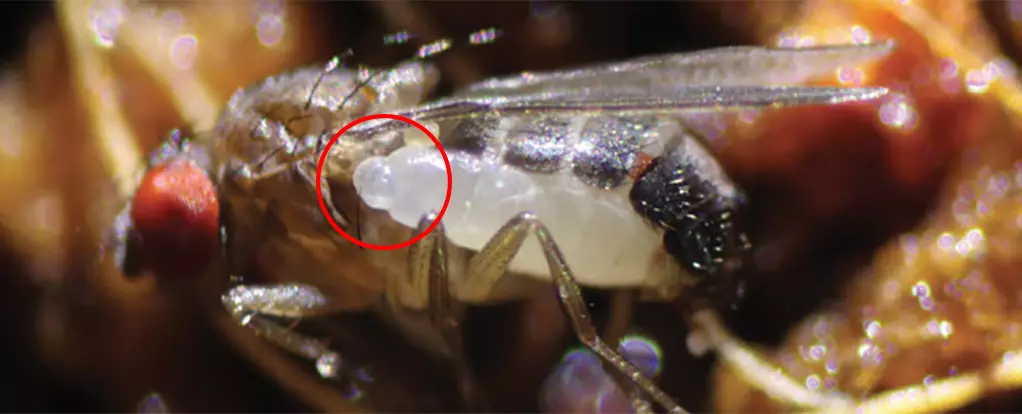In an astounding revelation, a group of biologists made a groundbreaking discovery involving a previously unidentified species of wasp, Syntretus perlmani. What distinguishes this new wasp from its fellow parasitoids is its unorthodox breeding ground: the abdomen of adult fruit flies, specifically the Drosophila species. This revelation not only expands our understanding of parasitoid behavior but also poses significant questions about the ecological dynamics that allow such relationships to flourish. While the parasitic wasp life cycle typically involves larval development within juvenile insects, Syntretus perlmani challenges conventional wisdom by targeting fully grown hosts, a phenomenon not documented in existing literature.
The serendipitous discovery originated from a swing at backyard traps in Mississippi during March 2023, which initially aimed to investigate nematode infections in fruit flies. Instead of nematodes, researchers stumbled upon a startling sight: a larvae nestled within the abdomen of a male adult fruit fly. The researchers’ excitement stemmed from the confirmed identity through advanced mitochondrial DNA sequencing that revealed the unique nature of this wasp. As the team transitioned from mere observation to following the lifecycle of the parasitoid, the extent of the peculiar relationship between the wasp and its fly host began to unfold.
Over the course of 11 months, more than 6,000 male Drosophila affinis specimens were collected from the southeastern United States to elucidate the prevalence of this relationship. The findings were intriguing yet puzzling; the infestation rates were found to fluctuate between 0.5% and 3%, while infections were nearly absent in females, suggesting specific mating behaviors or susceptibility that could play a role in this fascinating ecological niche.
Bizarre Life Cycle and Development
The life cycle of Syntretus perlmani is deeply entwined with the fate of its host. Upon oviposition, it takes roughly 18 days for the larva to fully develop while the host remains alive. This remarkable biological strategy allows the wasp to gain optimal conditions for growth, as the adult fly presents a more suitable environment than its juvenile counterparts. With the larva anchored within the host’s internal structure, a wry evolution unfolds—curiously similar to the concept of a chestburster, as it eventually emerges by eating its way out of the host’s body.
Furthermore, the rapid reproduction of female wasps evolving so quickly post-emergence suggests an extraordinary adaptation—a swift lifecycle allows them to colonize ecological niches effectively. Within just 24 hours of their emergence, female Syntretus perlmani lay eggs into new fly hosts, thereby restarting a cycle that reflects the relentless pace of nature’s evolutionary crucible.
This wasp’s unique behavioral strategies highlight significant opportunities for future ecological research. The researchers note that this discovery is not only relevant in understanding complex ecological interactions but also has broader implications for studies on immunity, metabolism, and behavior within both the host and the parasite sciences. The ease of collecting the wasp from backyard traps also presents an attractive feature for biological experimentation—setting a stage for comprehensive examination and potential functional studies.
The research extends further into the area of laboratory models, as Syntretus perlmani demonstrated successful parasitism on Drosophila melanogaster—an organism that has played a crucial role in genetic studies. The potential to establish Syntretus perlmani as a vector for studying biological interactions opens doors for innovative research avenues in various life sciences, essentially merging field biology with laboratory experimentation.
The discovery of Syntretus perlmani has led to a paradigm shift in the examination of parasitoid relationships, illustrating how biodiversity often unfolds in unexpected forms. By embracing the peculiar practices of these wasps, researchers are not only uncovering new layers of ecological complexity but also challenging our understanding of life cycles and relationships in nature. It serves as a reminder that the natural world is replete with hidden wonders waiting to be unveiled, revealing the intricate tapestry of life that binds organisms in ways we are yet to fully comprehend. As scientists continue to grapple with these new findings, the importance of Syntretus perlmani in ecological and evolutionary systems is poised to lead them into uncharted territories of biological inquiry.


Leave a Reply